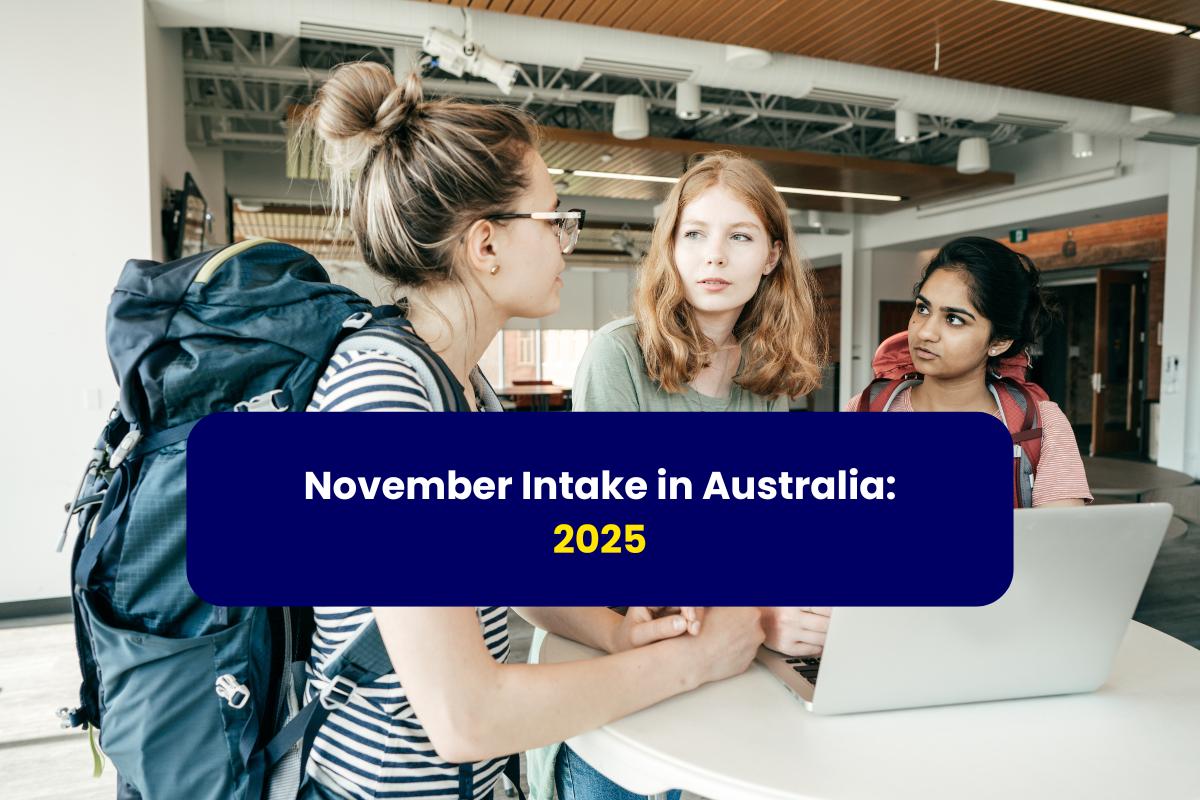November Intake in Australia: Deadlines & How to Apply

November Intake in Australia: Deadlines & How to Apply
When you picture starting a new academic journey, the November intake of Australia universities might not be the first thing that comes to mind. Most students naturally imagine beginning in February or July. But here's a little-known fact: you don’t have to wait for those intakes to kickstart your studies in Australia. The November intake, also known as Session 3 at many universities, offers Indian students a golden opportunity to start early, plan better, and get ahead.
Whether you’re just beginning your professional path, switching careers, or looking to upskill, the November intake may be the perfect window to begin, without waiting for the new calendar year.
Why Start in November?
If You Know What You Want, Why Wait?
Starting in November helps you ease into the system without the rush and crowd of the February or July cohorts. When your goals are clear, there’s no point in delaying. The November intake in Australia allows you to dive into your studies, whether you're a first-time student, working professional, or career switcher.
A Head Start on Your Degree
Getting started during the summer months (Nov-Feb in Australia) lets you complete one or two subjects before the major intake begins. You ease into university life, adjust to new systems, and gain momentum early.
Time & Mental Space to Study
Industries like education, trade, taxation, childcare, and factories often slow down toward the end of the year. A November start can provide the breathing room needed to concentrate fully on your studies, especially if you’re working in one of these industries.
Secure Your Pathway to Degree Programs
If you want to study a course that requires prerequisites, use the November intake of Australia universities. You have the opportunity to build essential foundational skills before diving into your core coursework. For instance, future nursing students can brush up on bioscience, or business students can prepare for finance courses, giving them the edge when classes begin in full swing in February.
Available Student Support Services
Starting in November also means you get exclusive access to key support services with fewer students around, making help more accessible:
-
Orientation programs tailored to international students
-
Academic bridging or foundation courses
-
One-on-one mentoring and student advisors
-
Career guidance and resume workshops
-
Dedicated help desks for accommodation, travel, and health insurance
Popular Universities Accepting November Intake
Many universities, particularly those with a strong focus on career-ready and vocational education, proudly offer excellent programs in November, giving students more flexible and high-quality options to start their studies.
-
Charles Sturt University
Known for strong industry connections and affordable tuition, CSU often offers November intakes in Business, IT, and Health Sciences. -
Federation University Australia
This supportive university, located in regional Victoria, offers a November intake for in-demand courses such as Business, Engineering, and IT. -
University of Southern Queensland (UniSQ)
Offers flexible learning modes and rolling intakes across programs in Education, Communication, and Technology. -
Southern Cross University
With campuses across NSW and QLD, SCU provides November starts in Health, Tourism, and Environmental Science courses. -
Torrens University Australia
Known for innovation and employability-focused education, Torrens has multiple intakes, including November, across Design, Business, and Hospitality. -
Victoria University
Offers the unique block model and multiple entry points, including November, for programs in Business, Education, and Sports Science.
Eligibility Criteria for University Admission
Academic Requirements
-
Undergraduate: Minimum 60–65% in Class XII (state or central boards).
-
Postgraduate: A recognized bachelor’s degree (3 or 4 years, depending on the course/university).
English Language Proficiency
|
Test |
Minimum Score |
|
IELTS Academic |
Overall 6.5 (no band < 6.0) |
|
TOEFL iBT |
Total ≈ 79–90 (varies by university) |
|
PTE Academic |
Typically ≈ 58–65 (mid-50s for some programs) |
|
Cambridge C1 Advanced (CAE) |
Equivalent to IELTS 6.5 |
|
OET (Health Programs) |
B in each component per program requirements |
How to Apply for the November Intake within the Timeline
Step 1: Start with Research (Feb – May 2025)
Begin by identifying your academic goals and matching them with suitable programs and institutions that offer a November (Trimester 3 or Session 3) intake timeline.
-
Use trusted platforms like the Gradsearch Tool to discover programs in business, IT, healthcare, and engineering. Explore courses around the world using our smart course finder tool to compare courses in Australia. Customize your search using filters like course, college, or country.
-
Check university websites to ensure that your chosen course is available in the November session.
-
Download the Australia Study Guide 2025 for a breakdown of admission requirements, timelines, and scholarships.
Step 2: Review Admission Criteria and Gather Required Materials (Mar – Jun 2025)
Each university and course has specific entry requirements. You should:
-
Review academic eligibility (e.g., minimum 60–65% in Class XII for UG or a recognized bachelor’s degree for PG).
-
Review English language requirements.
-
Begin preparing all the documents.
Step 3: Take Required Standardized Tests (Jun – Jul 2025)
It’s time to fulfill the university’s English language requirement through recognized testing.
-
Register for IELTS, TOEFL iBT, PTE Academic, or Cambridge C1 Advanced.
-
Prepare to achieve at least the standard score, typically a 6.5 on the IELTS or its recognized equivalent.
-
Some PG programs (e.g., MBA) may require GMAT/GRE. Check with individual universities.
-
Some universities accept Duolingo or internal English assessments. Verify with the institution.
Step 4: Submit Your Applications (Aug – Sep 2025)
With your scores and documents ready, submit your application within Australia university application deadline via:
-
The university’s online application portal
-
Or through a verified education consultant or representative
Be sure to:
-
Pay any application fee (varies by institution)
-
Upload all required documents in the correct format
-
Track your application status after submission. Turnaround time for decisions is usually 2–4 weeks.
Step 5: Receive Offer & Accept Admission (Sep 2025)
After confirming your acceptance, the university will issue either a conditional or an unconditional offer.
-
Conditional Offer: Pending test scores or final documents
-
Unconditional Offer: You’ve met all admission criteria
To confirm your seat:
-
Confirm your acceptance of the offer through formal written or electronic communication.
-
Pay the initial tuition fee deposit
-
Receive your Confirmation of Enrolment (CoE). It is essential for your visa application
Step 6: Apply for Subclass 500 Student Visa (Oct – Early Nov 2025)
With your CoE in hand, begin your Australian student visa application through the Australian Government's ImmiAccount portal.
Prepare the following:
-
CoE (Confirmation of Enrolment)
-
Valid passport
-
English test score (IELTS, TOEFL, etc.)
-
Proof of financial capacity (bank statements, loans, scholarships)
-
Genuine Temporary Entrant (GTE) statement
-
Overseas Student Health Cover (OSHC)
-
Medical and character certificates (if required)
Visa processing usually takes 4–6 weeks, but apply as early as possible.
Step 7: Plan Your Travel & Pre-Departure Logistics (Nov 2025)
Following visa approval, you can commence planning your move.
-
Book your flight to Australia
-
Secure on-campus or off-campus accommodation
-
Attend pre-departure webinars or sessions conducted by your university
-
Get familiar with student life in Australia: budgeting, part-time work, transport, healthcare, etc.
-
Have your pre-arrival checklists
-
Arrive 2–3 weeks before classes begin to attend orientation and settle in.
Scholarships to Watch for
If you’re planning to begin your studies in November at Australia universities, you’ll be pleased to know that there are several generous scholarship opportunities available. These are designed specifically to support international students, especially high-achieving applicants from India.
The scholarships are offered by both the Australian government and individual universities. They play a key role in easing the financial burden of studying abroad.
-
Australian Government Research Training Program (RTP): Primarily for postgraduate research students, this scholarship covers full tuition fees, provides a living stipend of around AUD 45,000 (approximately ₹22.5 lakhs), and may also support research-related costs.
-
Global Academic Excellence Scholarship by The University of Adelaide: This scholarship rewards top-performing students with partial tuition waivers ranging from AUD 9,000 to AUD 12,000 (around ₹4.5 to ₹6 lakhs), depending on academic performance.
-
Vice Chancellor’s International Scholarship: a scheme offered by multiple universities, including the University of Sydney and Macquarie University. It provides funding of up to AUD 40,000 (about ₹20 lakhs) to be used toward tuition fees across the duration of the degree.
-
Vice Chancellor’s International High Achievers Scholarship by Charles Darwin University: High-performing international students can apply for the scholarship. The award has the potential to fund as much as 50% of your educational expenses. It is equivalent to savings of around AUD 20,000 or ₹10 lakhs, making it an ideal option for academically strong applicants.
-
To support academic excellence, the University of Western Australia provides a scholarship opportunity for top-tier undergrad and postgrad candidates. This award can offer up to AUD 48,000 (around ₹24 lakhs) in tuition support, distributed across the program.
-
For students from developing countries, including India, who need complete financial support for their studies, the ADB–Japan Scholarship Program stands out as an excellent option. Funded by the Asian Development Bank, this award includes tuition, living expenses, and travel costs, with a total value of roughly AUD 45,000 (or ₹22.5 lakhs).
-
Finally, Griffith University offers the Remarkable Scholarship, which can cover up to 50% of tuition fees. This is especially suited for students with an excellent academic background and a strong application profile, potentially saving around AUD 20,000 or more.
Rounding Up
November intake in Australia universities presents an exciting opportunity without waiting for the traditional intake timelines. With lower competition, flexible timelines, and a head start on your studies, this lesser-known intake can open doors to top-quality education at leading and mid-range Australian universities.
Head over to our Resources Hub, your all-in-one library packed with 2025 Study Abroad Guides, downloadable planning checklists, and expert how-to content to help you navigate every step with confidence.
Whether you're looking to fast-track your study abroad goals or take that first leap into international education, book Gradstar’s one-to-one free counseling session today.


